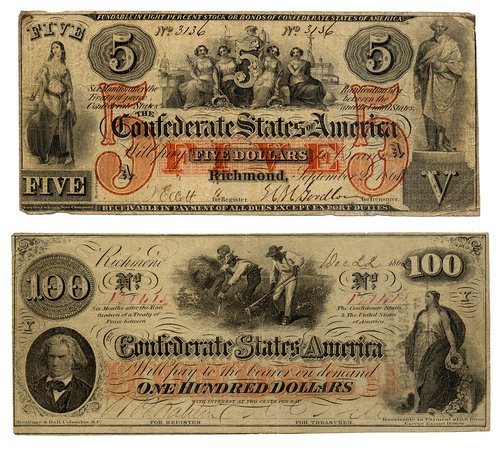Student Work

“A five and one hundred dollar Confederate States of America interest bearing banknote. These notes were authorized by the Confederate Congress during the Civil War (1861–1865). The Union banknotes had green printing on the back and were known as greenbacks. The backs of Confederate banknotes were blank and in circulation became a dirty gray. They became known as “gray-backs”.
This image was included in the 2011 edition of A Short History of the Civil War by James L Stokesbury. Published by Harper, ISBN 978-0-06-206478-3. “
https://en.wikipedia.org/wiki/Confederate_war_finance#/media/File:Confederate_5_and_100_Dollars.jpg
Post-Civil War Debt and Small Business
By: Brannan Davis
Neilson’s Department Store, the South’s oldest department store, is nestled in the heart of the city’s square. Currently, the store strictly sells retail clothing. However, Neilson’s offered an array of inventory in its earlier years. Along with clothing, Neilson’s stocked goods such as cigars, candy, various fruits, and even oysters. Such things were costly during the 20th century, begging the question, what exactly were people buying during a time of great debt and economic turmoil in the post-Civil War South?
The Civil War left the South stricken with a crippling debt. By 1860, at the dawn of the war, the stage had been set for a detrimental blow to the post war southern economy. In this age, the South’s primary source of industry was agriculture. Even though the North was not restricted to only farming, [1] “northern farmers were out-producing their southern counterparts in several important areas, as Southern agriculture remained labor intensive while northern agriculture became increasingly mechanized.” Besides its under developed technology, the South was actually very wealthy. Its inherent flaw wasn’t a lack of money, but what the funds were focused on. [2] “In 1860, the economic value of slaves in the United States exceeded the invested value of all of the nation’s railroads, factories, and banks combined,” making the south without slaves virtually worthless. By the end of the Civil War, the South was left with hundreds of thousands of dollars in unpaid debt. One could assume the perils of such an economy on small businesses such as Neilson’s.
Back during the Civil War era, Neilson’s ran their books on a charge account system. Viewing their books may put you under the impression that ordinary people were able to afford luxury items such as the oysters, cigars, and leather goods. However, with some context and a closer look at the ledgers, the people of Oxford did not seem to have as much money as their accounts led on. For example, pages from J.E. Neilson’s Blotter book recount personal notes he sent to his customers owing money. One such note dated December 19, 1877 exhibits Neilson’s strong urger for reimbursement. [3] The note reads that the customer needs to settle his account “immediately.” It was understood that not only would most Southerners be in need of money, but that Mr. Neilson – one of the wealthiest men in Oxford – was no exception.
One can assume that the mass amounts of unpaid ledgers hurt Neilson’s. As with any business, even in the present day, a compromised economy is a recipe for disaster and bankruptcy, yet Neilson’s is still standing. Legend has it that before the war, Neilson buried all his money in gold. Mr. Neilson knew that the Union would seize his assets if he didn’t hide them, and so he decided to put it in the ground for safe keeping. This intuition was what led him to be able to rebuild the store which still enjoys success today.
[1] Arrington, Benjamin T. “Industry and Economy during the Civil War.” Nps.gov. http://www.nps.gov/resources/story.htm?id=251.
[2] Arrington, Benjamin T. “Industry and Economy during the Civil War.” Nps.gov. www.nps.gov/resources/story.htm?id=251.
[3] W.S. Neilson “Blotter”, 19 December 1877, Inventory for the Neilson Department Store Ledger Collection, Department of Archives and Special Collections. The University of Mississippi Libraries.
